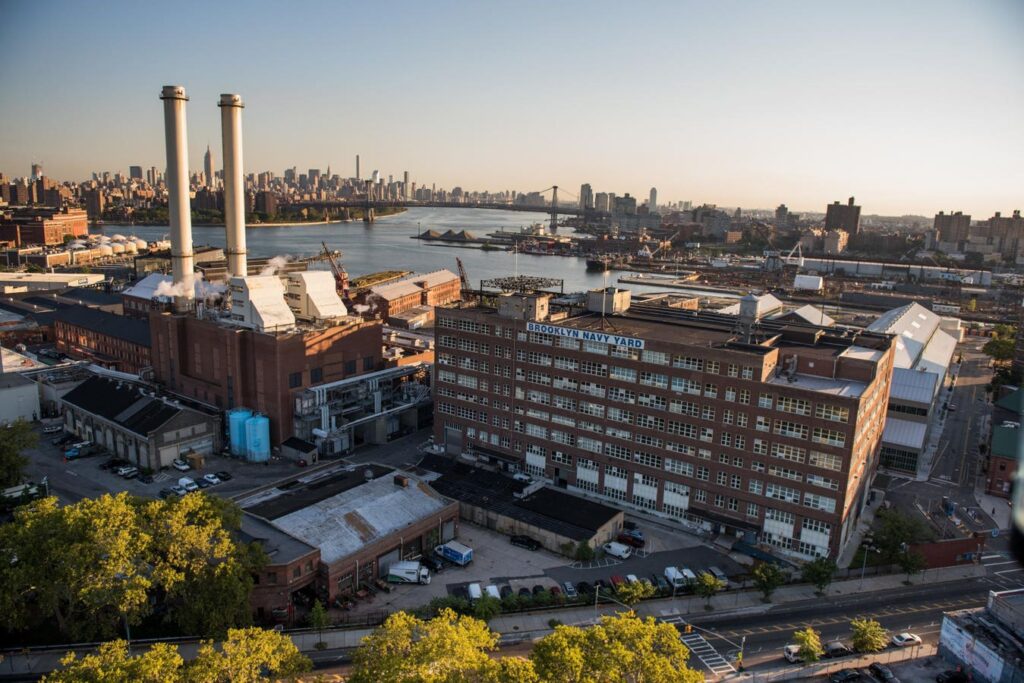New York City’s Brooklyn Shipyard was once known as the “Can Do Shipyard,” based on its reputation for rapid ship production and repair during World War II. Pennsylvania’s Bethlehem Steel forged steel girders used in erecting the Golden Gate Bridge and Empire State Building. Kansas City, Kan.-based Fairfax Industrial District was where World War II B-25 bombers were cobbled together. And Pittsburgh, Pa.’s Hazelwood Green steel mill stood as a powerful 20th Century symbol of the city’s industrial brawn.
Today, these once-humming industrial complexes have seen remarkable comebacks and have become vital cogs in their cities’ respective economies. The roles they serve today, however, are very different than those they played early last century.
For instance, the Brooklyn Navy Yard has become a 300-acre industrial park housing more than 550 businesses, employing 13,000 people and generating more than $2.5 billion each year in economic impact. The Yard shines in workforce development, training the next generation of skilled workers through its CNC operator training program. Its lively Market@77 community-focused food hall gives Brooklynites and visitors to the borough a place to meet each other while supporting local vendors.
Almost all of the more than 100-year-old buildings that were part of the Brooklyn Navy yard – and nearly all of them brick-clad — have been retained intact. That includes preservation and active use of Dry Dock 1, the third dry dock to be built in the U.S. in the 19th Century, and since 1975 a New York City landmark.
Reborn hub
Bethlehem Steel ended its manufacturing operations in Pennsylvania’s Lehigh Valley in 1994, but the site is now again serving the valley’s modern economy. Lehigh Valley Industrial Park 7 blankets more than 1,000 acres, and is home to three dozen industrial, manufacturing, office and retail businesses. More than 4,300 jobs have been created by the complex, which has attracted more than $650 million in private investment.
K.C.’s Fairfax Industrial District, established 103 years ago, is now home to more than 130 businesses, employs 10,000 workers and annually generates more than $5.4 billion in sales. Enterprises within its borders range from one-person companies to enormous corporations such as Kellogg’s, CertainTeed, Owens Corning and General Motors.
And Hazelwood Green in Pittsburgh has been reborn as an advanced biotechnology manufacturing hub that supports innovation and economic development. Carnegie Mellon University’s Robotics Innovation Center is housed there, as is an innovation hub and incubator spearheaded by OneValley, a Silicon Valley-based platform that links entrepreneurs, startups and organizations across the globe.
Challenges, rewards
If turning these 20th Century relics into modern economic powerhouses sounds easy, it has been anything but.
Within Brooklyn Navy Yard, for instance, rehabilitating for modern use legacy buildings and infrastructure originally intended for Naval shipyard purposes proved an immensely daunting undertaking, says Lindsay Greene, chief executive officer and president for the Brooklyn Navy Yard Development Corporation.
“Many of the buildings, roads, and waterfront infrastructure – like piers, berths and dry docks – were uniquely constructed, requiring us to have to creatively adapt and transform the campus for modern industrial uses,” she said.
“Following a period of approximately 30 years of strategic investment and deliberate tenanting strategies in partnership with the City of New York, the Brooklyn Navy Yard Development Corporation has been able to rehabilitate, restore and reinvent the industrial hub for modern manufacturing needs.”
Support for the project began during the mayoralty of Rudy Guiliani in the late 1990s, and gained momentum, along with private and public funding, during the tenure of Mayor Michael Bloomberg. “In the last 15 to 20 years, much of that city funding has been supplemented by a boost in state and federal grants,” Greene said. “We’ve also creatively leveraged historic tax credits to rehabilitate some of the historic properties.”
If everything old really is new again, Brooklyn Navy Yard, Lehigh Valley, Fairfax Industrial District and Hazelwood Green are some of the best examples, demonstrating what’s possible when fresh innovation takes root within legacy manufacturing sites.
Read the full article here

